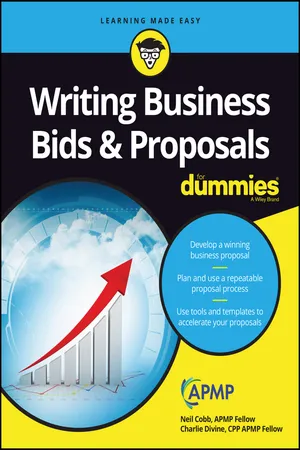
- English
- ePUB (mobile friendly)
- Available on iOS & Android
Writing Business Bids and Proposals For Dummies
About this book
Acquire the necessary skills to win business through proposals, bids, tenders, and presentations—this hands-on guide is your partner for success
You have in your hands the collected knowledge and skills of the professional proposal writer. Proposal writing is a profession — a growing and increasingly important one and an essential part of a broader group of business development professionals who plan and execute strategies for businesses who want to obtain new customers. Proposal writers have a professional organization — the Association of Proposal Management Professionals (APMP) — and their best practices are the foundation for this book.
Proposal writing is a skill you can learn, practice, and master; you can even go through a professional certification process to prove your mastery. Writing Business Bids & Proposals For Dummies is your no-nonsense guide to finding out what professional proposal writers know and for applying it to your own business.
If you're a small- to medium-size business owner, a first-time proposal writer in a medium-size company, or a sales representative, you know that a written proposal (printed or electronic) is still a common, personal, and effective way to win business. Written in plain English, Writing Business Bids & Proposals For Dummies will help you to:
- Know the difference between reactive proposals (the RFP or request for proposal) and proactive proposals
- Focus on the customer by going beyond their requirements to address their true needs
- Know your competition through research and analysis
- Write persuasively to develop a winning business proposal
- Plan and use a repeatable proposal process
- Incorporate a lessons learned aspect to your proposal process
- Use tools and templates to accelerate your proposals
- Motivate and lead your proposal team to ensure they're on the same page
- Use graphics to enhance your proposals
- Learn ways to automate your proposal development process
- And a whole lot more
Additionally, you'll gain access to ten templates for building a proposal, find out ten common misconceptions about bids and proposals, and add a compiled list of online resources to your toolset. Grab a copy of Writing Business Bids & Proposals For Dummies to start sharpening your proposal writing skillset.
Frequently asked questions
- Essential is ideal for learners and professionals who enjoy exploring a wide range of subjects. Access the Essential Library with 800,000+ trusted titles and best-sellers across business, personal growth, and the humanities. Includes unlimited reading time and Standard Read Aloud voice.
- Complete: Perfect for advanced learners and researchers needing full, unrestricted access. Unlock 1.4M+ books across hundreds of subjects, including academic and specialized titles. The Complete Plan also includes advanced features like Premium Read Aloud and Research Assistant.
Please note we cannot support devices running on iOS 13 and Android 7 or earlier. Learn more about using the app.
Information
Understanding Proposal Development
Introducing Bids and Proposals
Defining Bids and Proposals
- Proposals submitted further to a formal request from the customer: These are sometimes referred to as solicited proposals. You may also hear them called reactive proposals, because you can’t really anticipate all their requirements. More often, these proposals are called RFP responses, because the customer issues a Request for Proposal. We opt for that term throughout this book.
- Proposals that you give the customer independently of any request: These usually follow deep discussions about the customer’s business needs and are called either proactive or unsolicited proposals. Instead of the customer requesting a proposal, you ask the customer to accept your proposal. We prefer the term proactive because it indicates that you write these on your own initiative (plus, it’s easier to say).
Looking at the differences between RFP responses and proactive proposals
Understanding the structure of RFP responses
- Describe the background of the customer and its business problem.
- Lay out the rules that the customer expects all bidders to follow, including any terms and conditions of a potential contract.
- List the specific requirements that the customer needs you to address as you solve the problem. These requirements often take the form of questions. They may cover not only how your solution will work but also how your company will implement and manage the solution.
- Specify pricing components (usually in separate spreadsheets, depending on the complexity of the project).
Understanding the structure of proactive proposals
- An executive summary that recaps needs and benefits, win themes, and value propositions in language that speaks to decision makers
- A description and illustration of the current environment or problem
- Your recommendation for creating a new, improved environment or for solving the problem, comparably illustrated to show the changes in the customer’s world
- A statement of work that describes how you’ll set up the solution and maintain it
- A pricing summary that focuses on benefits, value, and return on investment
- A final recap of benefits and an action close to outline next steps
Adjusting your process for RFP responses and proactive proposals
PLAYING BY THE RULES
Table of contents
- Cover
- Title Page
- Table of Contents
- Introduction
- Part 1: Understanding Proposal Development
- Part 2: Focusing on Your Customer
- Part 3: Planning Your Approach
- Part 4: Creating Your Proposal
- Part 5: Taking Your Proposal to the Next Level
- Part 6: The Part of Tens
- Appendix: Online Resources
- About the Authors
- Advertisement Page
- Connect with Dummies
- End User License Agreement

